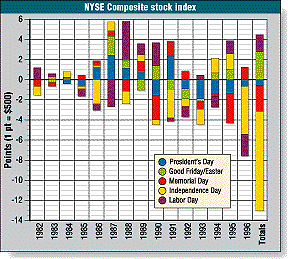Combined with overvaluation,
mutual fund mania and a blue-chip market that has not experienced a 10% correction in more than six years, the seasonal and cyclical forces suggest 1997 could be a difficult year for the stock market.
PRE- AND POST-HOLIDAY PERFORMANCE
"In Figures 1 and 2, the performance prior to major holidays is examined, along with the day after Thanksgiving and the day after Christmas. Listed is the net change in value of the nearby New York Stock Exchange (Nyse) Composite stock index contract on the day before the holiday, or the day after in the cases of the two holidays above. The total change for each holiday since 1982 is listed at the bottom of each table. Each point on the contract (1.00) is equal to $500."


"Clearly, using this strategy prior to holidays since the advent of stock index futures contracts has not been very rewarding. Since 1982, the sum total of all of the trades works out to a net loss of -4.25 points, and that doesn't even include slippage and commission costs. The holiday with the best performance has been Thanksgiving, while the holiday with the worst performance has been Independence Day. Though mutual funds could be used as a substitute without incurring transactions costs, the performance of the futures contracts implies there has been little to gain on these days. This is in stark contrast to the results prior to 1982, which showed a remarkable tendency toward consistent gains."